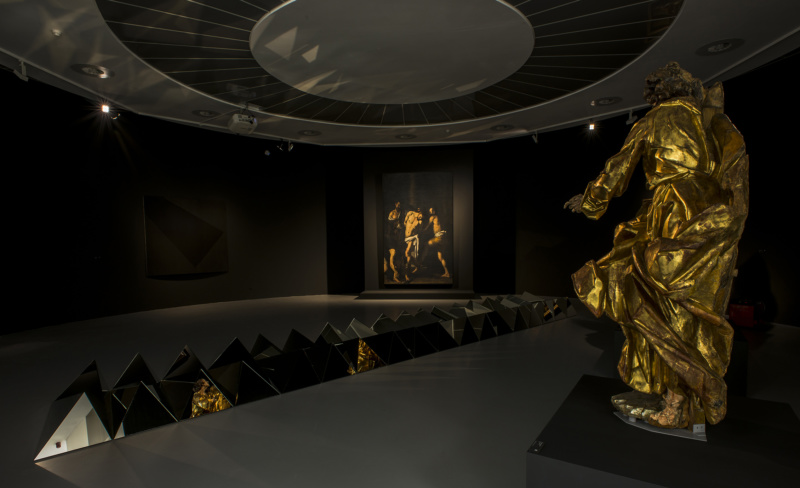
Among the experts on the Baroque period, there has never been a consensus on what the word actually means. An early definition put forward by 18th-century art historians Johann Winckelmann and Heinrich Wölfflin places characteristics of the Baroque in contrast to those of the Renaissance, while a more contemporary perspective à la John Martin in the 1970s boldly declared that it was impossible to find homogeneity in the Baroque period as its distinguishing feature is its diversity of styles.
In “Sanguine/Bloedrood: Luc Tuymans on Baroque,” Tuymans, here as curator, grapples with the complexities of the idea of a “baroque sensibility” as part of his curatorial approach for the exhibition, which currently occupies the first-floor galleries of Antwerp’s Museum of Contemporary Art (M HKA) as well as an inflatable dome in a nearby parking lot where Ed Kienholz’s seminal installation Five Car Stud (1969–72), depicting the horrors of racial violence, has been recreated. Tuymans uses the plurality of the Baroque as a critical tool for exploring the big issues of life, and to simultaneously present these issues in a “big” way. Sanguine/Bloedrood juxtaposes more than 40 artists including classical baroque masters such as Peter Paul Rubens, Caravaggio, Francisco de Zurbarán and Johann Georg Pinsel alongside contemporary artists such as Berlinde De Bruyckere, Pascale Marthine Tayou, Jack Whitten and Marlene Dumas. According to Tuymans, the exhibition “takes up the notion of impact when encountering art.”
Past and present artworks are in dialogue with one another throughout the show and as one enters the first gallery, it is evident that “Sanguine/Bloedrood” intends to overwhelm viewers with an array of artworks spanning media and scale. The first work encountered is Javier Téllez’s El Léon de Caracas (The Lion of Caracas) (2002), a video installation where a stuffed lion representing the symbol of the capital city is paraded by four armed servicemen in a slum neighborhood, creating a sensation as they descend from a densely populated hilly terrain down to a curious crowd. The only audio in the film is booming classical music which makes for a theatrical perspective on one of the most dangerous cities in the world and comments on the blind adoration of a fake lion as national symbol.

In the next space—populated by more than a dozen works by David Gheron Tretiakoff, Nadia Naveau, Jack Whitten, Pascale Marthine Tayou, Marcel Gautherot and Jan Fabre amongst others—Tretiakoff’s four-part Immolation (2016) series stands out for its depiction of four Arab revolutionaries who publicly set themselves on fire and in so doing, heralded the beginning of the Arab Spring. The martyrs Mohamad Bouazizi from Tunisia, Ahmad Hachem as-Sayyed from Egypt, Ahmad al-Matarneh from Jordan and Hamza Al-Khatib from Syria, are all rendered by the artist as drawings made from cigarette burns on silk. The physical act of burning used by the artist is a direct reference to self-immolation, burning at the stake and other acts of violence directed at the humans either part of protest movements or as torture techniques.
With Figaro’s Triumph (2014), Naveau brilliantly channels the indeterminate nature of the Baroque with three sculptures moulded in white plaster, the missing parts of which are filled in with different materials to make the intervention visible while adding a reference point as a time stamp. Moving on from these works leads to the eye-catching mirrored sculpture Circa Tabac (2007) by Carla Arocha & Stéphane Schraenen. Circa Tabac is a triangular floor-piece that fragments the images of the paintings surrounding it as one walks across the room, creating a prism-like experience of Caravaggio’s La Flagellazione di Cristo (1607–08), Francisco de Zurbarán’s The Martyrdom of Saint Sebastian (ca.1650–55) and Johann Georg Pinsel’s Our Lady (1758), zooming in on the highly dramatized depictions of these religious iconographic images. Nearby, Berlinde De Bruyckere’s In Flanders Fields (2000) installation of fallen horses representing the horrors of WWI resonates with contemporary warfare. Surrounding De Bruyckere’s installation is On Kawara’s Date Paintings series (NOV.14, 2007 and NOV.14, 2008 (2007–08) and APR.8, 1978 (1978), which speak to the idea that the calendar is a human construct, and that quantifications of time are shaped by cultural contexts and personal experiences.
The exhibition ends with a visit to Keinholz’s landmark Five Car Stud, first shown at Documenta 5 and now installed in a carpark next to the museum. Inside, the viewer encounters the utterly horrific staging of a life-size depiction of the mutilation of an African-American man by five white men in Halloween masks, with the others watching the act unfold. The aggressors hold the man’s arms and legs, while one of them prepares to castrate him. The installation adopts an Artaudian approach of assaulting the audience using lights, imagery, sound and music to shock them into confronting themselves, itself a very Baroque gesture. With maimed black bodies a recurring occurrence in both past and present histories and considering Belgium’s colonial history and context of ethnic and racial discrimination towards its non-white citizens, this installation comes across as gratuitous and lacking its original impact as a shocking reminder of American history still lingering today. As Angela Davis reminds us, “particularly in relation to African American historical images, we need to find ways of incorporating them into social and political memory, instead of using [them] as a substitute which encourages the atrophy of such memory.” Experiencing Five Car Stud however, is a reminder that there is still an urgency for the radical rethinking of our visions of safety—and the means we all devote to achieving this are needed more today than ever.
Overall, “Sanguine/Bloedrood” is a visually opulent and challenging exhibition. With old masters on view in the experimental spaces of contemporary art, Tuymans successfully brings together the disparity of the Baroque, illuminating the many ways in which the term can be understood and applied both historically and in the contemporary.
Craving more culture? Sign up to receive the Cultured newsletter, a biweekly guide to what’s new and what’s next in art, architecture, design and more










 in your life?
in your life?

